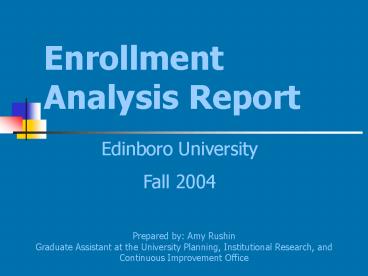Enrollment Analysis Report - PowerPoint PPT Presentation
1 / 21
Title: Enrollment Analysis Report
1
Enrollment Analysis Report
Edinboro University Fall 2004
Prepared by Amy Rushin Graduate Assistant at the
University Planning, Institutional Research, and
Continuous Improvement Office
2
- The enrollment analysis report contains data as
of the freeze date for Fall 2004. - This report uses data to analyze the extent to
which student success has been achieved with the
intent of refining processes and informing
university leadership of enrollment management
trends for strategic planning purposes. - This report links enrollment accomplishments with
the Universitys mission to create and share
knowledge by providing access to education and
learning experiences for the academic, cultural
and personal growth of the students and the
larger community we serve in order to determine
if we are fully achieving that mission. - Note All data sourced in this report was
obtained from the Edinboro University Fact Book
2004-2005.
3
Trends that have increased from previous years
are highlighted in green.
Trends that have decreased from previous years
are highlighted in red.
Trends that were not compared to previous years
are highlighted in blue.
4
Total Enrollment/Student Classification
?Edinboro Universitys headcount enrollment for
Fall 2004 was 7,773 reflecting a decline of 272
students (headcount) from Fall 2003. Trend
chart follows.
?Of the 7,773 total enrollment 6,735 consisted of
undergraduate and 1,038 graduate students a
number which reflects the largest graduate
enrollment in the Universitys history. Trend
chart follows.
5
Total Enrollment/Student Classification
(continued)
6
Transfer Students
? As of the freeze date in Fall 2004, 452
transfer students were enrolled out of the 681
that were accepted and the 1017 that applied.
This enrollment number reflects a slight decrease
from Fall 2003 which had a total transfer
enrollment of 466 students.
7
Student Gender
? Of the total enrollment for Fall 2004,
approximately 59 are female and 41 are male.
These percentages are very similar when compared
to Fall 2003 enrollment 59 for females and 41
for males. See trend chart below and on
following slide.
8
Student Gender (continued)
9
Student Ethnicity
? Total enrollment trends in the Fall 2004 have
risen for the following ethnic groups
Black/Non-Hispanic 6.79 American Indian/Alaskan
Native .22 Asian/Pacific Islander .75 and
Unspecified/Multi-racial .15. The largest
increase was seen in Black/Non-Hispanic
enrollment with a percentage gain of .54. See
trend chart on next slide.
? Total enrollment trends in the Fall 2004 have
decreased for the following ethnic groups
Hispanic 1.02 White/Non-Hispanic 88.76 and
Non-Resident Alien 2.32. The largest decrease
was seen in Non-Resident Alien enrollment with a
percentage loss of .56. See trend chart on
next slide.
10
Student Ethnicity (continued)
11
Student Ethnicity (continued)
12
The Freshman Class
? As of the freeze date, approximately 87 of the
incoming freshman students were from in-state
11 were from out-of-state and 2 were
international students. ? The top 3 PA counties
that are represented in the Fall 2004 enrollment
are Erie (48.33), Crawford (15.46) and,
Allegheny (9.45). The top three states
represented are Pennsylvania (6835), New York
(309), and Ohio (305). ?The top 3 countries
represented by Non-Resident Alien Students are
Japan (15.56), Nigeria (10.00), and Mongolia
(5.56). See trend charts on following
slides
13
The Freshman Class (continued)
14
The Freshman Class (continued)
15
The Freshman Class (continued)
? SAT scores for the Fall 2004 freshman class
are down slightly from last fall with
approximately 46 scoring within the 400-499
range on SAT I verbal, and approximately 47
scoring within the 400-499 range on SAT I math.
Trend chart follows.
? ACT scores have also decreased from
approximately 57 scoring in the 18-23 range last
fall to approximately 55 scoring in the same
range for Fall of 2004. Trend chart follows.
16
The Freshman Class (continued)
17
The Freshman Class (continued)
?The percentage of freshman students that were in
the top half of their high school graduating
class has increased slightly from 52 in Fall
2003 to 53 in Fall 2004. The percentage of
students in the top 10th of their high school
graduating class has remained the same at 6.
18
Degrees Awarded
? The number of students receiving baccalaureate
degrees and certificates has increased from 2003
to Fall 2004.
? The number of students receiving master and
associates degrees has decreased from 2003 to the
Fall of 2004.
19
Degrees Awarded (continued)
? Increases in degrees awarded from 2003 to 2004
can be seen in the School of Education (32.3),
the School of Science, Management and Technology
(19.9), and Academic Support Services (3.8).
Trend chart follows.
? A slight decrease is observed in the degrees
awarded in the School of Liberal Arts from 2003
to 2004, with the 2004 percentage at 44. Trend
chart follows.
20
Degrees Awarded (continued)
21
Questions? Comments?
- ?Please direct your questions and/or comments to
the University Planning, Institutional Research
Continuous Improvement Office (UPIRCI). - ?(814) 732-2656
Thank you!































